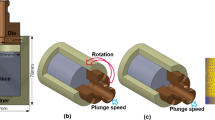Abstract
Inconel 718 is one of the most widely used super alloys in industries like oil and gas, aerospace and automobile. However, properties like poor thermal conductivity and work hardening tendency make it difficult to machine, using a conventional machining approach. EDM is one of the effective and efficient ways of machining this exotic material. However, the material removal rate (MRR) is very low. In an attempt to enhance the performance of EDM, an arc machining module has been integrated into the existing EDM system and the compound process is named hybrid electrical discharge and arc machining (HEDAM). Due to the high thermal intensity of the sparks/arcs imparted by this process, the material removal rate is elevated.
To understand this process better, a comparative thermal modelling between HEDAM and EDM has been presented in this article. Firstly, a thermal analysis is performed for the EDM and HEDAM processes to understand their respective erosion efficiencies. Finally, the numerical simulation for MRR of both EDM and HEDAM is presented. Unlike other EDM models, in this simulation, the thermophysical properties of the material were considered to be temperature-dependent and the latent heat of fusion was incorporated into the modelling process. A comparative analysis was also performed, which showed that incorporating such variables increases the accuracy of the obtained results. The study revealed that the spark radius in HEDAM is larger in size and more stable. Consequently, this resulted in HEDAM to have about three times more erosion efficiency compared to conventional EDM.
Similar content being viewed by others
References
Rahman M, Seah WKH, Teo TT (1997) The machinability of inconel 718. Journal of Materials Processing Tech 63(1):199–204. https://doi.org/10.1016/S0924-0136(96)02624-6
Dudzinski D, Devillez A, Moufki A, Larrouquère D, Zerrouki V, Vigneau J (2004) A review of developments towards dry and high speed machining of inconel 718 alloy. Int J Mach Tools Manuf 44(4):439–456. https://doi.org/10.1016/S0890-6955(03)00159-7
Umbrello D (2013) Investigation of surface integrity in dry machining of inconel 718. Int J Adv Manuf Technol 69(9):2183–2190. https://doi.org/10.1007/s00170-013-5198-0
Ay M, Çaydaş U, Hasçalık A (2013). Optimization of micro-EDM drilling of inconel 718 superalloy. Int J Adv Manuf Technol, 66(5–8), 1015-1023
Somashekhar KP, Panda S, Mathew J, Ramachandran N (2015) Numerical simulation of micro-EDM model with multi-spark. Int J Adv Manuf Technol 76(1–4):83–90. https://doi.org/10.1007/s00170-013-5319-9
Yadav V, Jain VK, Dixit PM (2002) Thermal stresses due to electrical discharge machining. Int J Mach Tools Manuf 42(8):877–888. https://doi.org/10.1016/S0890-6955(02)00029-9
Allen P, Chen X (2007) Process simulation of micro electro-discharge machining on molybdenum. J Mater Process Tech 186(1):346–355. https://doi.org/10.1016/j.jmatprotec.2007.01.009
Tlili A, Ghanem F, Salah NB (2015) A contribution in EDM simulation field. Int J Adv Manuf Technol 79(5):921–935. https://doi.org/10.1007/s00170-015-6880-1
Sweet JN, Roth EP, Moss M (1987) Thermal conductivity of inconel 718 and 304 stainless steel. Int J Thermophys 8(5):593–606. https://doi.org/10.1007/BF00503645
Ahn DG, Byun KW, Kang MC (2010) Thermal characteristics in the cutting of Inconel 718 Superalloy using CW Nd: YAG laser. J Mater Sci Technol 26(4):362–366. https://doi.org/10.1016/S1005-0302(10)60059-X
Basak D, Overfelt RA, Wang D (2003) Measurement of specific heat capacity and electrical resistivity of industrial alloys using pulse heating techniques. Int J Thermophys 24(6):1721–1733. https://doi.org/10.1023/B:IJOT.0000004101.88449.86
Brooks CR, Cash M, Garcia A (1978) The heat capacity of inconel 718 from 313 to 1053 K. J Nucl Mater 78(2):419–421. https://doi.org/10.1016/0022-3115(78)90463-4
Kamnis S, Gu S, Zeoli N (2008) Mathematical modelling of inconel 718 particles in HVOF thermal spraying. Surf Coat Technol 202(12):2715–2724. https://doi.org/10.1016/j.surfcoat.2007.10.006
Singh H, Shukla DK (2012) Optimizing electric discharge machining parameters for tungsten-carbide utilizing thermo-mathematical modelling. Int J Therm Sci 59:161–175. https://doi.org/10.1016/j.ijthermalsci.2012.03.017
Wong YS, Rahman M, Lim HS, Han H, Ravi N (2003) Investigation of micro-EDM material removal characteristics using single RC-pulse discharges. J Mater Process Tech 140(1):303–307. https://doi.org/10.1016/S0924-0136(03)00771-4
Kumar DS (2009) Heat And Mass Transfer (Two Colour). S. K. Kataria & Sons
Kansal HK, Singh S, Kumar P (2008) Numerical simulation of powder mixed electric discharge machining (PMEDM) using finite element method. Math Comput Model 47(11):1217–1237. https://doi.org/10.1016/j.mcm.2007.05.016
Weingärtner E, Kuster F, Wegener K (2012) Modeling and simulation of electrical discharge machining. Procedia CIRP 2:74–78. https://doi.org/10.1016/j.procir.2012.05.043
Patel MR, Barrufet MA, Eubank PT, DiBitonto DD (1989) Theoretical models of the electrical discharge machining process. II. The anode erosion model. J Appl Phys 66(9):4104. https://doi.org/10.1063/1.343995
Zhang B, Tian X, Wang W, Tang X, Wang P (2014) Numerical and experimental investigations on micro-detonation of striking arc machining of alumina. Proc Inst Mech Eng B J Eng Manuf 228(6):918–930. https://doi.org/10.1177/0954405413509078
Tsai NS, Eagar TW (1985) Distribution of the heat and current fluxes in gas tungsten arcs. Metall Trans B 16(4):841–846. https://doi.org/10.1007/BF02667521
Zhang Q, Zhang M, Wang H, Liu G, Guo T (2015) Research on a single pulse discharge to discriminate EDM and EAM based on the plasma tunnel and crater geometry. J Mater Process Tech 219:248–256. https://doi.org/10.1016/j.jmatprotec.2014.12.016
Erden A (1983) Effect of materials on the mechanism of electric discharge machining (E.D.M.) J Eng Mater Technol 105(2):132. https://doi.org/10.1115/1.3225627
Shabgard M, Ahmadi R, Seyedzavvar M, Oliaei SNB (2013) Mathematical and numerical modeling of the effect of input-parameters on the flushing efficiency of plasma channel in EDM process. Int J Mach Tools Manuf 65:79–87. https://doi.org/10.1016/j.ijmachtools.2012.10.004
Pandey PC, Jilani ST (1986) Plasma channel growth and the resolidified layer in edm. Precis Eng 8(2):104–110. https://doi.org/10.1016/0141-6359(86)90093-0
Author information
Authors and Affiliations
Corresponding author
Rights and permissions
About this article
Cite this article
Ahmed, A., Fardin, A., Tanjilul, M. et al. A comparative study on the modelling of EDM and hybrid electrical discharge and arc machining considering latent heat and temperature-dependent properties of Inconel 718. Int J Adv Manuf Technol 94, 2729–2737 (2018). https://doi.org/10.1007/s00170-017-1100-9
Received:
Accepted:
Published:
Issue Date:
DOI: https://doi.org/10.1007/s00170-017-1100-9




